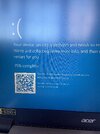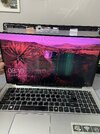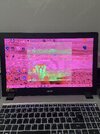Hi,
I have an Acer aspire V 15 laptop
V3-574-7321
Windows 10 64 bit
We use the program ‘driver easy’ and about 2-3 weeks ago and a few drivers were updated.
About a week or so later we got a BSOD, error “UCMUCSI Failure”. It did carry on working and then the same error came up 2 or 3 times. I tried running the DISM and SFC scans. It did say something was repaired but didn’t seem to make a difference and the BSOD came up again.
Then about a week later the screen went pink and Green, blurry and almost has an overlay behind what is currently on the screen, showing old things that were in the screen underneath. It almost sounds like the fan is kicking in and running harder now while it’s not doing anything.
I rolled back all the driver updates to when it was previously ok but that didn’t make a difference.
I then reset the computer and installed a fresh windows 10 64 bit but that didn’t work either.
If I plug in an external monitor, on the external monitor, the display is fine, so I think that’s telling me display driver, a display component, the screen itself or the display cable.
Like I said I have rolled back driver updates so I don’t think it’s that (although quite coincidental timing)I have stripped the pc down looking for anything obvious componente level or any loose connections especially on the display cable but I couldn’t see anything. I did unplug and reply display in and wobble the cable while plugged in and display on to see if it made the display worse or better but it didn’t make a difference.
What would be best to look at or try next? Any advice is appreciated.
I have an Acer aspire V 15 laptop
V3-574-7321
Windows 10 64 bit
We use the program ‘driver easy’ and about 2-3 weeks ago and a few drivers were updated.
About a week or so later we got a BSOD, error “UCMUCSI Failure”. It did carry on working and then the same error came up 2 or 3 times. I tried running the DISM and SFC scans. It did say something was repaired but didn’t seem to make a difference and the BSOD came up again.
Then about a week later the screen went pink and Green, blurry and almost has an overlay behind what is currently on the screen, showing old things that were in the screen underneath. It almost sounds like the fan is kicking in and running harder now while it’s not doing anything.
I rolled back all the driver updates to when it was previously ok but that didn’t make a difference.
I then reset the computer and installed a fresh windows 10 64 bit but that didn’t work either.
If I plug in an external monitor, on the external monitor, the display is fine, so I think that’s telling me display driver, a display component, the screen itself or the display cable.
Like I said I have rolled back driver updates so I don’t think it’s that (although quite coincidental timing)I have stripped the pc down looking for anything obvious componente level or any loose connections especially on the display cable but I couldn’t see anything. I did unplug and reply display in and wobble the cable while plugged in and display on to see if it made the display worse or better but it didn’t make a difference.
What would be best to look at or try next? Any advice is appreciated.





